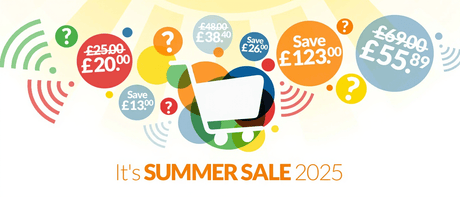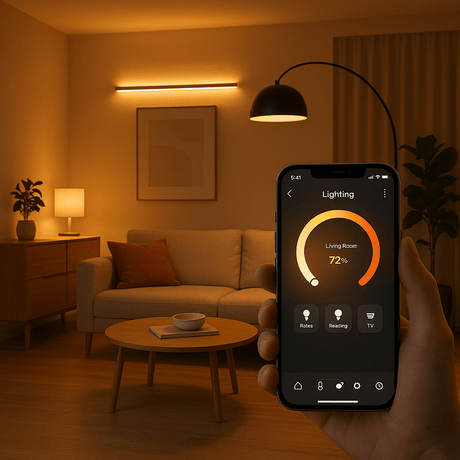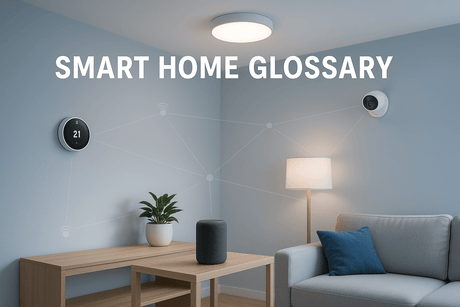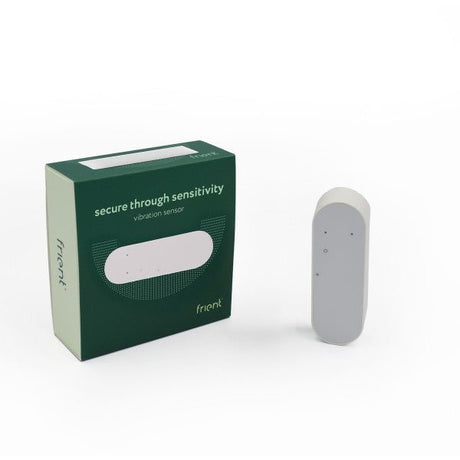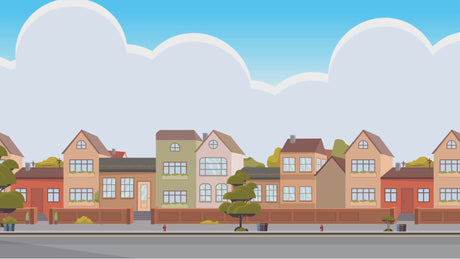Embarking on your smart home journey can feel overwhelming with the vast array of devices and technologies available today. As a first-time buyer, you might be wondering which smart devices will provide the most value and convenience while fitting seamlessly into your lifestyle. This guide highlights 10 essential smart home devices that offer the perfect starting point for beginners, providing practical benefits without unnecessary complexity.
Each recommendation focuses on devices that deliver immediate value, are relatively easy to set up, and can be expanded upon as your smart home grows. We'll explore how these devices can enhance your daily life, what features to look for, and how they integrate into a comprehensive smart home ecosystem.
1. Smart Home Controller (Hub)
Why It's Essential: A smart home controller serves as the central nervous system of your smart home, allowing different devices to communicate with each other and enabling you to manage everything from a single interface.
At the heart of every truly integrated smart home lies a quality controller or hub. While some smart devices can operate independently via Wi-Fi, a dedicated controller supporting Z-Wave or Zigbee protocols offers significant advantages:
-
Unified Control: Manage all your devices from a single app instead of juggling multiple manufacturer-specific applications
-
Enhanced Reliability: Z-Wave and Zigbee create mesh networks that become stronger and more reliable as you add devices
-
Advanced Automation: Create sophisticated routines that trigger multiple actions across different brands of devices
-
Reduced Network Congestion: Keeps smart devices off your Wi-Fi network, improving overall performance
-
Better Security: Dedicated smart home protocols typically offer stronger security than Wi-Fi-only solutions
When selecting your first
Smart Home Controller , consider one that supports both Z-Wave and Zigbee to maximize compatibility with future devices. Popular options include dedicated hubs from brands like Hubitat and Home Assistant, as well as USB stick controllers that connect to a computer.
For beginners, look for controllers with intuitive interfaces, good community support, and regular software updates to ensure long-term viability.
2. Smart Plugs
Why They're Essential: Smart plugs offer the simplest way to begin automating your home, requiring no electrical knowledge while instantly making existing appliances and lamps "smart."
Smart Home Plugs simply insert between your electrical outlet and any device you want to control, instantly adding remote control, scheduling, and automation capabilities. Their versatility makes them perfect for:
-
Automating Lamps: Turn existing lamps on/off based on time, presence, or other triggers
-
Managing Electronics: Power down energy-hungry devices when not in use
-
Seasonal Decorations: Control holiday lights or decorations on schedules
-
Small Appliances: Automate coffee makers, fans, heaters, or other plug-in devices
-
Away Mode Security: Randomly turn lights on/off to simulate occupancy while you're away
Look for smart plugs that support your chosen smart home protocol (Z-Wave or Zigbee) rather than Wi-Fi-only models, as they'll integrate more seamlessly with your controller and contribute to your mesh network. Also consider energy monitoring features, which can help identify power-hungry appliances and optimize your electricity usage.
Smart plugs provide immediate benefits with minimal investment, making them the perfect entry point for smart home beginners.
3. Motion Sensors
Why They're Essential: Motion sensors serve as the "eyes" of your smart home, triggering lighting, security features, and other automations based on movement and occupancy.
Smart Home Sensors that detect motion are among the most versatile and useful devices in any smart home. They enable truly responsive environments that adapt to your presence without requiring manual control. Key applications include:
-
Automated Lighting: Lights that turn on automatically when you enter a room and off when you leave
-
Security Monitoring: Notifications when motion is detected while you're away
-
Energy Efficiency: Ensuring devices only run when spaces are occupied
-
Pathway Lighting: Illuminating hallways, stairs, or bathrooms at night for safety
-
Occupancy Awareness: Informing other systems about which rooms are in use
Modern motion sensors are designed to be unobtrusive, with small form factors that can be placed discreetly on walls, shelves, or ceilings. Many also include additional capabilities like light level sensing, temperature monitoring, or humidity detection, providing even more data for your smart home system.
For best results, place motion sensors in high-traffic areas like entryways, hallways, and living spaces. Battery-powered models offer flexible placement without wiring concerns, while mains-powered versions typically provide more consistent performance without battery maintenance.
4. Door/Window Sensors
Why They're Essential: Door and window sensors provide fundamental security awareness and can trigger a wide range of useful automations beyond just security alerts.
These simple but powerful
Smart Home Sensors consist of two parts that detect when doors or windows are opened or closed. While security is their most obvious application, their usefulness extends much further:
-
Security Monitoring: Receive alerts when doors or windows open unexpectedly
-
Climate Control Efficiency: Automatically adjust heating or cooling when windows are left open
-
Smart Lighting Triggers: Turn on lights when you enter through specific doors
-
Custom Notifications: Get reminders if the garage door is left open or when children arrive home
-
Occupancy Awareness: Help your smart home understand when people are coming and going
Door/window sensors are typically battery-powered and easy to install with adhesive mounting, making them accessible even for renters. They communicate wirelessly with your smart home controller, contributing to your mesh network and enabling a wide range of automations.
For beginners, focus first on exterior doors and frequently used windows. As your system grows, you can add sensors to interior doors, cabinets, or other areas where status monitoring would be valuable.
5. Smart Lighting Controls
Why They're Essential: Lighting is typically the most frequently used element in any home, making smart lighting controls one of the most immediately beneficial and noticeable smart home upgrades.
There are several approaches to smart lighting, each with different advantages:
-
Smart Switches and Dimmers: Smart Home Modules that replace existing wall switches, controlling your current light fixtures while maintaining traditional wall control
-
Smart Bulbs: Individual bulbs with built-in wireless connectivity, offering color changing and dimming without replacing switches
-
Smart Plugs with Lamps: Using smart plugs to control table or floor lamps, a simpler approach that requires no installation
For most beginners, smart switches and dimmers offer the best balance of functionality, reliability, and user-friendliness. They work with your existing fixtures and bulbs, maintain familiar wall control for all users, and typically offer better reliability than bulb-based solutions.
Smart lighting enables:
-
Automated Schedules: Lights that adjust based on time of day or sunrise/sunset
-
Motion-Based Control: Automatic illumination when rooms are occupied
-
Remote Control: Adjust lighting from anywhere via smartphone
-
Scene Creation: Set perfect lighting for different activities with a single command
-
Energy Savings: Ensure lights aren't left on in unoccupied spaces
When selecting smart lighting controls, ensure compatibility with your chosen smart home protocol and controller. For switches and dimmers, verify they're compatible with your existing wiring (particularly regarding neutral wire requirements).
6. Temperature and Humidity Sensors
Why They're Essential: Environmental monitoring provides valuable data for comfort, energy efficiency, and protecting your home from damage due to extreme conditions.
Smart Home Sensors that monitor temperature and humidity offer insights that go far beyond what a single thermostat can provide. By placing these sensors in different rooms, you can:
-
Optimize Comfort: Identify and address hot or cold spots throughout your home
-
Prevent Damage: Monitor humidity in bathrooms, basements, or attics to prevent mold growth
-
Protect Valuables: Ensure proper conditions for wine collections, musical instruments, or other sensitive items
-
Improve HVAC Efficiency: Use multi-room temperature data to better balance your heating and cooling system
-
Track Trends: Understand how your home's environment changes throughout the day and seasons
These sensors are typically battery-powered and wireless, making them easy to place anywhere without installation concerns. Many models combine temperature and humidity sensing with other capabilities like motion detection or light level monitoring, providing even more value.
For beginners, start with sensors in your most frequently used living spaces and any areas with known temperature issues or humidity concerns. The data collected will help you understand your home better and can inform future smart home expansions.
7. Smart Remotes and Scene Controllers
Why They're Essential: While smartphone control is powerful, dedicated physical controls provide convenient access to your smart home for all household members, including guests, children, and those less comfortable with technology.
Smart Home Remotes bridge the gap between traditional controls and fully digital interfaces. These purpose-built devices offer:
-
Dedicated Buttons: Trigger specific devices or entire scenes with a single press
-
Intuitive Control: Familiar physical interaction that anyone can understand
-
No App Required: Immediate access without unlocking phones or navigating apps
-
Strategic Placement: Position controls exactly where they're needed most
-
Guest-Friendly Operation: Allow visitors to control essential functions without access to your smart home app
Smart remotes range from simple button controllers to sophisticated multi-button panels. Wall-mounted options provide consistent placement similar to traditional switches, while portable remotes offer flexibility to control your environment from anywhere in the room.
For beginners, consider starting with a simple scene controller near your home's entrance or in your living room. Program buttons for everyday scenarios like "Arriving Home," "Movie Night," or "Bedtime" to experience the convenience of controlling multiple devices with a single press.
8. Water Leak Sensors
Why They're Essential: Water damage is among the most costly and disruptive home disasters, and early detection can prevent minor leaks from becoming major catastrophes.
Water leak
Smart Home Sensors are small devices placed near potential water sources that alert you at the first sign of moisture. Strategic placement includes:
-
Under Sinks: Detect plumbing leaks before they cause cabinet damage
-
Near Washing Machines: Monitor for hose failures or drainage issues
-
Around Water Heaters: Get early warning of tank leaks or pressure relief valve activation
-
Near Dishwashers: Identify seal failures or supply line issues
-
In Basements: Detect groundwater intrusion or sump pump failures
When a leak is detected, these sensors can trigger immediate notifications to your phone, allowing you to address the issue before significant damage occurs. More advanced setups can even automatically shut off your home's water supply using compatible smart water valves.
For first-time smart home buyers, water leak sensors offer peace of mind with minimal investment. Their potential to prevent thousands in water damage makes them one of the most financially justifiable smart home devices.
9. Smart Smoke and CO Detectors
Why They're Essential: Enhanced safety features and remote notifications make smart smoke and carbon monoxide detectors a significant upgrade over traditional models, potentially saving lives when you're away from home.
Smart smoke and CO detectors connect to your smart home system to provide:
-
Remote Alerts: Receive notifications on your phone when alarms trigger, even when you're away
-
Interconnected Operation: When one detector activates, all can sound to ensure alerts are heard throughout the home
-
Automatic Safety Responses: Trigger HVAC shutdown during fire, turn on lights for evacuation, or unlock doors for emergency responders
-
Regular Self-Testing: Many models automatically test themselves and report any issues
-
Low Battery Warnings: Receive notifications before batteries fail, eliminating middle-of-the-night chirping
While these devices typically cost more than standard detectors, their enhanced safety features and integration capabilities provide value that extends far beyond basic detection. For homes with existing conventional detectors, specialized listening devices can monitor for alarm sounds and provide smart notifications without replacing your current units.
For beginners, consider starting with smart detectors in sleeping areas and near potential sources of fire or carbon monoxide, then expanding to cover the entire home over time.
10. Smart Energy Monitoring
Why It's Essential: Understanding your home's energy usage provides insights that can lead to significant cost savings while helping reduce your environmental impact.
Smart energy monitoring systems range from whole-home solutions that connect to your electrical panel to individual
Smart Home Plugs with built-in power monitoring. These systems help you:
-
Identify Energy Hogs: Discover which appliances and devices consume the most electricity
-
Track Usage Patterns: Understand when and how you use energy throughout the day
-
Set Usage Alerts: Receive notifications when consumption exceeds normal patterns
-
Measure Improvements: Quantify the impact of energy-saving efforts
-
Optimize Scheduling: Run high-consumption devices during off-peak rate periods
For beginners, start with smart plugs that include energy monitoring features. Use these to analyze your most frequently used or suspected high-consumption devices. This targeted approach provides immediate insights without the complexity or cost of whole-home monitoring systems.
As your smart home grows, you can expand to more comprehensive energy management solutions that integrate with solar systems, battery storage, or time-of-use utility programs.
Building Your Smart Home: A Strategic Approach
Rather than purchasing all these devices at once, consider a phased approach that allows you to learn and expand your system gradually:
Phase 1: Foundation (Months 1-2)
- Smart home controller/hub
- 2-3 smart plugs
- Motion sensors for main living areas
- Door sensors for exterior entrances
Phase 2: Expansion (Months 3-4)
- Smart lighting controls for frequently used rooms
- Temperature/humidity sensors
- Smart remote or scene controller
- Additional motion sensors for other areas
Phase 3: Enhancement (Months 5-6)
- Water leak sensors
- Smart smoke/CO detectors
- Energy monitoring
- Additional specialized sensors based on your specific needs
This measured approach allows you to become comfortable with each component before adding complexity. It also helps distribute the cost over time while ensuring each addition integrates well with your existing setup.
Choosing the Right Protocol: Z-Wave and Zigbee
For the most reliable and future-proof smart home, focus on devices that use Z-Wave or Zigbee protocols rather than Wi-Fi-only solutions. These specialized smart home technologies offer:
-
Mesh Networking: Devices extend the network range for each other
-
Low Power Consumption: Battery-operated devices can run for months or years
-
Reliability: Less interference and network congestion than Wi-Fi
-
Interoperability: Devices from different manufacturers work together
-
Security: Advanced encryption and protection against unauthorized access
While Wi-Fi devices may seem simpler at first (no hub required), they often create a fragmented experience with multiple apps and no central control. Z-Wave and Zigbee devices, when paired with a quality controller, provide a more integrated, reliable, and expandable system.
Conclusion: Your Smart Home Journey Begins
The 10 essential devices outlined in this guide provide an excellent foundation for first-time smart home buyers. Each offers tangible benefits while contributing to a comprehensive system that can grow with your needs and interests.
Remember that the most successful smart homes are built gradually, with each addition serving a specific purpose rather than implementing technology for its own sake. Focus on devices that solve real problems or enhance your daily life in meaningful ways.
As you begin your smart home journey, explore
Vesternet's curated collections of controllers, sensors, modules, and more to find quality components that will serve as the building blocks of your intelligent home. With the right foundation and a thoughtful approach to expansion, you'll create a smart home that truly enhances your comfort, convenience, and peace of mind for years to come.













